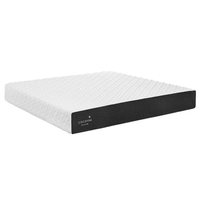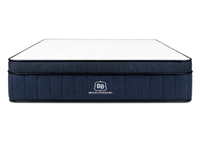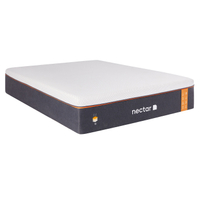The short answer is that yes, memory foam can hold onto body heat. Fortunately, many manufacturers have made great strides in developing cooling foams (and gels) to help you sleep more comfortably while enjoying the sink-in comfort of these beds. That means today’s best memory foam mattresses are great at regulating temperature, and won’t leave you waking up feeling overheated. While those innovative cooling technologies are now trickling down to the affordable end of the market, cheaper memory foam beds can often still sleep on the warm side. Here we explain how some memory foam mattresses are hot, and how you can guarantee a cooler night’s sleep on one.
What is memory foam?
Memory foam is made from a material called viscoelastic and was originally designed by NASA to use as cushioning in aircraft seats. It’s used in the medical sector and has now filtered down to consumer products – perhaps most commonly mattresses, but you’ll also find it in many of today’s best pillows. A typical all-foam bed contains a memory foam comfort system combined with a high-density polyfoam support core. The contouring effect makes these mattresses particularly suited to side and back sleepers, as they help to keep the spine aligned and relieve pressure at the shoulders, hips and back. Memory foam also absorbs motion, preventing movement from spreading across the mattress, making them excellent for those who share a bed and don’t want to be disturbed by their partner wriggling around. Lastly, the material is naturally hypoallergenic, so allergy sufferers usually turn to them. The closest competitor to memory foam, in terms of pressure relief and contouring, is latex, though latex is bouncier, so it doesn’t isolate motion quite as well (for further guidance, read our memory foam vs latex mattresses comparison).
Are memory foam mattresses good for your sleep? A look at the pros and cons
Are memory foam mattresses hot to sleep on?
Traditional memory foam mattresses first appeared in the 1990s and quickly gained popularity for their ability to cradle the body and provide excellent pressure relief. But these mattresses were definitely hot. There are a few reasons why memory foam retains body heat. One is the material’s structure – the dense foam has less airflow than other materials. Imagine the structure of a metal coil; there’s space for air to move around it and through the mattress. The air holes in foam are much smaller. Some brands try to improve this by adding bigger perforations to their memory foam, and you’ll also find some that use open cell foam, which allows for better airflow, but ultimately the foam needs to be fairly dense to provide support. A compromise that many people go for is to opt for a hybrid model that combines springs and foams, as these tend to sleep cooler than all-foam mattresses. A second reason that memory foam can be hot is because of the way that memory foam contours and hugs the body. This is naturally going to trap the warm air against your body, and make it more difficult for your body to thermoregulate. Softer memory foams, with a lot of foam-to-skin contact, will be worse for this, while firmer foams that you sleep more on top of should let air circulate more freely… but then you sacrifice the hugging feeling that memory foam is known for. Fortunately, technology has moved on and recent innovations mean that memory foam mattresses nowadays are engineered specifically not to hang on to your body heat and radiate it back to you. (More on that later.)
Why is temperature important to sleep?
Studies (opens in new tab) have shown that humans tend to sleep better in cooler temperatures, with the ideal range for adults being between 60 and 67° F. Our sleep cycle is regulated by our circadian rhythm, which is based on the light and dark cycle of the sun and takes its cues from environmental and personal factors. Whilst our core body temperature is around 98.6° F (37° C), it fluctuates by about 2° in the night. Body temperature starts to drop around two hours before sleep, which triggers the release of melatonin, the sleep hormone. And during sleep, body temperature continues to fall. So if your bedroom is too warm your temperature will not start to fall. This affects not only sleep onset, but also sleep quality, your amount of unbroken sleep, and time spent in different sleep stages. This leads to grogginess and, over time, can negatively impact your immune system, memory, and even lead to specific health conditions.
Cooling memory foam materials
As previously mentioned, modern memory foam mattresses have plenty of innovative ways to help you stay cool during sleep. This includes the use of open cell foam, which allows air to flow more freely through the mattress. Another innovation is gel memory foam. This is typically infused with gel beads to absorb body heat, helping you to sleep cooler on a memory foam mattress. In fact, a couple of the all-foam models in our best cooling mattress guide use gel-infused foam. Different manufacturers have developed techniques to stop their foam from becoming hot. For example, mattresses in a box brand Casper uses its own AirScape tech. Here thousands of perforations in the foam direct body heat away from you during sleep. Casper has also developed a powerful cooling system called Snow Technology – read our Casper Wave Hybrid Snow Mattress review for more on that. Tempur-Pedic’s Breeze range, meanwhile, uses phase change technology to keep you cool, with its ProBreeze mattress helping you feel 3 degrees cooler than your room at night. Its LuxeBreeze promises to keep you 8 degrees cooler, but it’s one of the most expensive cool beds you can find. At the much cheaper end of the scale, the Tuft & Needle Original mattress has charcoal and gel embedded in the open cell foam – all of which combines for a chilled night’s sleep. Finally, Layla’s dual-firmness memory foam mattress is infused with copper particles to prevent overheating. The effectiveness of these technologies varies, and ultimately it’s best not to just go on a brand’s own claims when choosing which mattress to buy, but to research what customers have said. We specifically include a section on temperature regulation in all of our reviews.
How to sleep cool on a memory foam mattress
Although the type of mattress you’re sleeping on makes a huge difference to how hot you are in bed, it’s not the only thing to consider. As well as your bedroom environment, your bed frame and bedding can make a big difference to how cool or hot you sleep. So remember to consider all the elements that make up your sleep setup. Here are our top tips to a comfortably cool sleep on a memory foam mattress:
- Choose a cooling foam mattress These are designed to help you stay comfortably cool throughout the night, without the need to kick off all your covers. Some use innovative materials (as discussed above) to create a temperature-regulating surface, while others are made with foam infused with materials such as graphite, gel or charcoal to boost breathability.
- Reconsider your bed frame Boost the airflow of your mattress by making sure you’ve got the right bed frame underneath it. Slatted bed frames reduce heat retention as the gaps make it easier for air to circulate. A solid divan or a box spring base will hold more heat. The downside of a slatted bed frame? Over time it will become noisier, which could affect your sleep in a different way! Head to our guide to the best bed frames and bases has more info, plus some recommendations.
- Invest in breathable bedding For hot sleepers, it’s really worth investing in cooling bedding. If your sheets are too dense or thick, or made from artificial fabrics such as polyester, they are likely to retain heat. Instead choose natural fibers such as wool, cotton, bamboo or Tencel, or synthetic materials specifically designed to regulate temperature. Our guides to the best comforters and pillows will point you in the right direction.
- Add a cooling topper If you want to add extra comfort, cooling or support to your existing mattress, using one of the best mattress toppers delivers instantly. But the right topper can also help cool down a memory foam mattress that’s sleeping a little warm. Cooling toppers are made with infused foam to help regulate your temperature and draw heat away from your body. Most come with moisture-wicking covers that can be removed and washed, making your sleep space more hygienic.
3 cooling memory foam mattresses to consider
Sleeping hot but not sure where to start looking for a new bed? The following three options cover a range of prices and should hopefully provide you with your perfect fit…
Read more: The rule of thumb is that innerspring or hybrids will generally sleep cooler than all-foam mattresses, but good memory foam models will stay temperature-neutral, while still giving you the benefits of memory foam.
Our guide to the best mattress for side sleepersThe best Saatva mattress sales for hotel luxury for lessGo natural with the best organic mattressSleep calmer with a weighted blanketTempur-Pedic mattress sales and deals: what to shop


